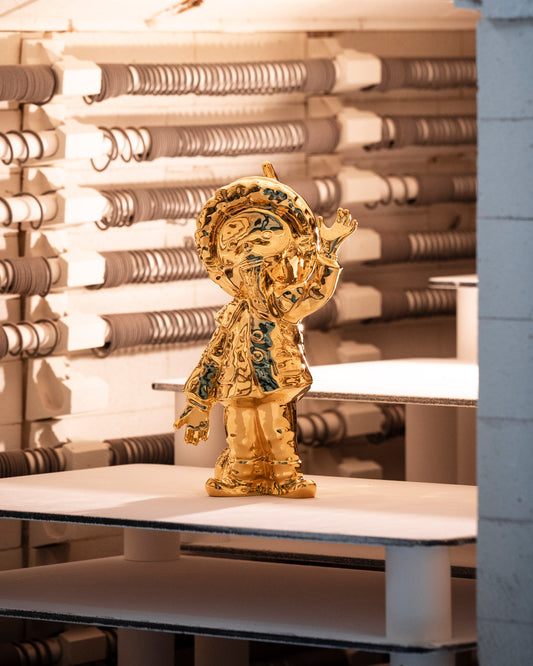THE BERLIN TEA MASTERS
The chemistry is right here. The LAB series from KPM Berlin and the trendy tea label P & T share a love of craftsmanship and a commitment to the highest level of enjoyment. An interview with Paper & Tea from our WEISS customer magazine No. 5...
KPM Berlin and the pioneers of modern tea culture Paper & Tea have been working together since 2020. Like working with porcelain, the skill of tea blending is a creative process and an art steeped in tradition.
What should you consider when preparing and serving tea?
On five things: Water quality, temperature, time, quantity of tea and room to develop. Water quality is important and we would always recommend filtered water, as hard tap water often has residues that affect the taste. If you want to go one step further, black teas and fermented pu-erh teas can do very well with a little more minerals in the water. Just try brewing the same tea with different waters. While some teas release their flavor notes very easily into the water, others need a much more intense infusion to develop their full potential. This is why we provide our customers with temperature and time recommendations for each tea. The quantity of tea also plays a major role: the more tea leaves, the more intense the taste. More tea also allows for several, shorter infusions and therefore different flavor profiles across the infusions. Last but not least, the tea should have enough space in the pot to rehydrate and develop its full flavor. Give your tea the space it deserves and don't cram it into tight tea eggs.
What do many people do wrong?
Most people prepare all teas - regardless of their degree of oxidation - in the same way. However, each type of tea needs its own individual preparation method in order to show its best taste profile. For example, if you pour boiling water over delicate green tea such as our Japanese Daikoku N°317, you will burn it. Black tea, on the other hand, often tastes too strong and bitter if it is steeped for too long.
The LAB Collection
What should I bear in mind when storing them?
Tea should be kept away from its five 'arch enemies': oxygen, moisture, heat, light, and strong aromas. Store your tea in airtight containers, ideally away from the spice rack. A little insider tip: Our finest green teas, and especially the limited harvests, are always kept in the refrigerator to maintain their special freshness.
What do people often not know about tea?
Colloquially, we refer to many things as "tea" that are not actually tea, such as peppermint, chamomile, or fruit tea. However, all true teas are obtained from a single plant, the Camellia Sinensis. This simple bush is the most complex plant in the world, with over 700 different ingredients that come into play to varying degrees depending on production. All six types of true tea come from this one plant: white, green, yellow, oolong, black tea, and fermented dark tea. They differ only in the method of production and drying. Within these six tea families, we find 3000 to 5000 different variations of pure tea.
What myths about tea are persistent?
One myth is that green tea is healthier than other teas. Tea is generally said to have many health-promoting properties: it strengthens the immune system and not only has a positive effect on our stress levels, but also lowers cholesterol levels and the Cancer risk. Green tea is praised as a fountain of youth, and of course it is actually healthy – just like all other teas, which also come from the same plant. Another myth: Many tea drinkers think that black tea contains the most caffeine – if they even know that teas also contain caffeine, and not the colloquial German term Teein. Caffeine was first discovered in tea in 1827 and called Teein. The subsequent realization that Teein and caffeine are chemically identical led to the abandonment of this old name and actually to the uniform name caffeine. Black tea has the highest degree of oxidation, but not necessarily the highest caffeine content. The rule of thumb is: the stronger a tea tastes, the more caffeine it contains. By the way: If you are looking for lower-caffeine tea, choose large-leaf tea that grows lower on the plant, such as some Oolongs, Japanese Kukicha – like our Kumano N°313 – or Houjicha – like our Daily Toast N°318.
With which varieties can you surprise guests?
Most people only know black and green teas, so we recommend delighting guests with the sweetness of delicate white teas, the floral notes of an Oolong or the complex aromas in Pu-Erhs for a completely new tea experience. It is also a surprise how good a high-quality chamomile or hibiscus infusion can taste. Our herbal blends are made from such high-quality herbs and plants that they have little in common with conventional herbal and fruit teas from the supermarket.
What trends are emerging in tea enjoyment?
One of the biggest trends over the last few years is and remains Matcha. In addition to its sophisticated taste and aroma, this very special green tea powder is also the heart of the Japanese tea ceremony. Moreover, Matcha is full of antioxidants and caffeine: both enjoy very high popularity these days. The discovery of this ancient tradition in its modern interpretation makes Matcha the new espresso.
An ideal tea for beginners?
If you have never tried one of our teas, you must try Golden Earl N°514. We are incredibly proud of this perfection of an Earl Grey. We don't want to brag, but the high quality of our ingredients makes this tea unique, because we only use the finest Chinese black tea and Italian bergamot oil: no additives, no perfume, just pure enjoyment.
KPM Berlin and Paper & Tea have been working together since 2020: What connects the two companies?
The contemporary design of the LAB series is perfect for our teas. It is inspired by the aesthetics of an elegant chemistry laboratory and, basically, good tea preparation is nothing other than pure chemistry. A perfect match, so to speak. Water slowly rehydrates the tea leaves and unleashes the ingredients in them until we perceive the different pigments, aromas, flavors and textures. That's why we have dedicated a highly oxidized oolong to the LAB series, an ode to nature that has been treasured by kings and queens: Our LAB OOLONG - available from October at KPM Berlin and Paper & Tea - only gets its incomparable taste with the help of little grasshoppers. The little Jacobiasca Formosana nibble on the tea leaves and trigger a chemical defense mechanism within the tea plant, which in turn gives this tea its incredibly deep aromas.
Text: Sandra Djajadisastra


